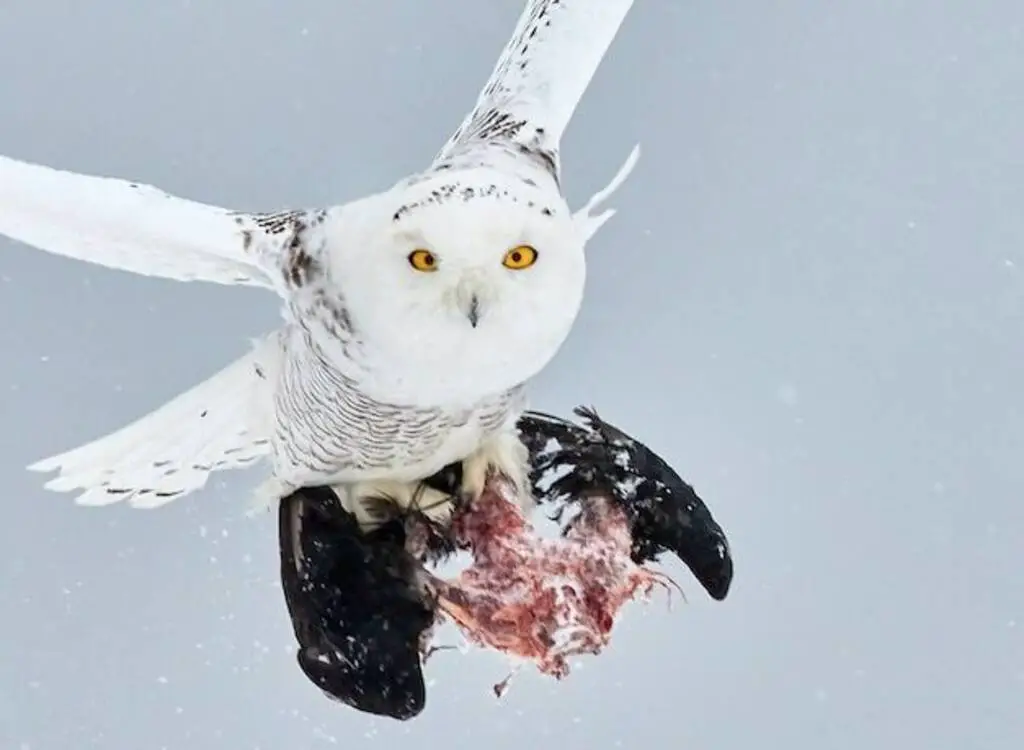Hoo goes there? It’s a question that has plagued the bird-watching community for years. Do owls eat hawks? The short answer is yes, and it’s not as uncommon as you may think.
But what drives these feathery predators to attack their own kind? Join us as we explore the fascinating world of birds of prey and discover the surprising reasons behind this aerial battle.
Table of Contents
- 1 Is the Owl or Hawk Stronger?
- 2 Owl Speed vs. Hawk Speed
- 3 Comparing the Diets and Hunting Habits of Owls and Hawks
- 4 Other Differences Between Hawks and Owls
- 5 Do Hawks and Owls Really Fight?
- 6 Do Owls Eat Hawks?
- 7 Owls’ Predatory Habits
- 8 Owls’ Diet and Prey
- 9 Types of Owls that Prey on Hawks: A Guide
- 10 Hawks: Predators and Prey
- 11 FAQs: Do Owls Eat Hawks?
- 11.1 Do All Owl Species Eat Hawks?
- 11.2 Why Would an Owl Eat a Hawk?
- 11.3 Do Hawks Attack Owls?
- 11.4 What Other Animals Do Owls Eat?
- 11.5 How Do Owls Hunt?
- 11.6 Are Owls Scared of Hawks?
- 11.7 What do owls do to hawks?
- 11.8 Is a hawk stronger than an owl?
- 11.9 What eats a hawk?
- 11.10 What is the food chain of an owl?
- 11.11 Can an owl take down a hawk?
- 12 Conclusion
- 13 Author
Is the Owl or Hawk Stronger?
Comparing the strength of an owl and a hawk is not a straightforward task, as different species of owls and hawks have different physical attributes and hunting strategies.
However, in general, owls are considered to have stronger talon grip force than hawks due to their hunting habits. Owls have specialized serrated talons that are designed to grab and hold onto prey tightly.
The grip strength of an owl’s talons can be very powerful, with some species having a grip strength of up to 500 pounds per square inch (psi).
This grip strength allows owls to catch and kill prey much larger than themselves, such as rabbits, squirrels, and even some small deer.
In contrast, hawks have sharp talons that are used primarily to catch and kill prey, rather than holding onto it. While hawks’ talon grip strength is not as powerful as that of owls, it is still significant. The grip strength of a hawk’s talons varies between species, but it is generally between 100 and 250 psi.
Therefore, while both owls and hawks are formidable predators, owls tend to have stronger talon grip force due to their specialized hunting techniques.
However, it is important to note that comparing the strength of different bird species is not always straightforward, and there can be variations in grip strength even within a single species depending on factors such as age, sex, and individual size.
Here’s a table comparing the talon grip force and strength of owls and hawks:
| Talon Grip Force | Strength | |
|---|---|---|
| Owls | Up to 500 psi | Powerful, can take down large prey |
| Hawks | Up to 300 psi | Agile and swift, able to catch prey in flight |
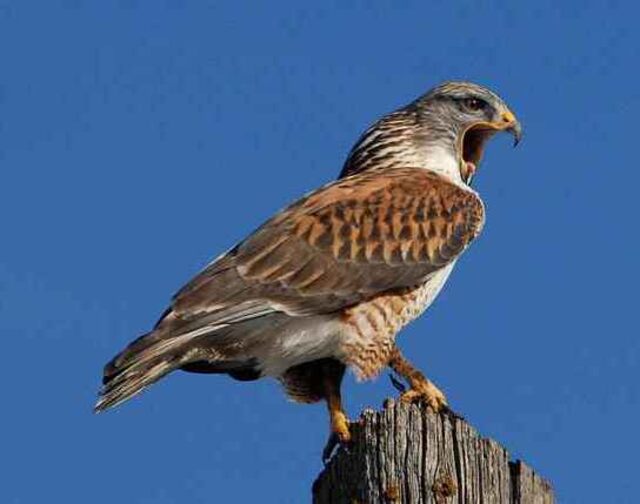
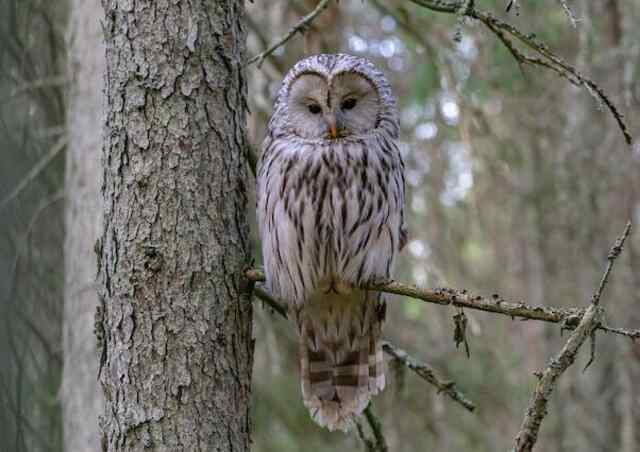
Owl Speed vs. Hawk Speed
Owls and hawks are both birds of prey, but they have different speeds. Owls are known for their silent flight, which allows them to fly almost undetected while hunting.
They fly slower than hawks, typically between 20–50 miles per hour, but can fly up to 60 miles per hour when in pursuit of prey.
On the other hand, hawks are known for their incredible speed and agility. They can fly at speeds of up to 150 miles per hour when diving to catch their prey.
Hawks use their speed to surprise and capture their prey in open spaces, while owls rely on their stealth and agility to catch prey in the cover of darkness.
Here’s a table comparing the cruising and diving speeds of some common owl and hawk species:
| Bird Species | Cruising Speed (mph) | Diving Speed (mph) |
|---|---|---|
| Great Horned Owl | 25-40 | 50-60 |
| Barn Owl | 50-60 | 80-90 |
| Snowy Owl | 50-60 | 60-70 |
| Peregrine Falcon | 50-60 | 240-280 |
| Red-tailed Hawk | 20-40 | 120-150 |
| Cooper’s Hawk | 20-40 | 60-70 |
It’s worth noting that these speeds can vary depending on factors such as wind speed, altitude, and the bird’s physical condition. Additionally, these speeds are based on estimates and averages, and individual birds may differ in their abilities.
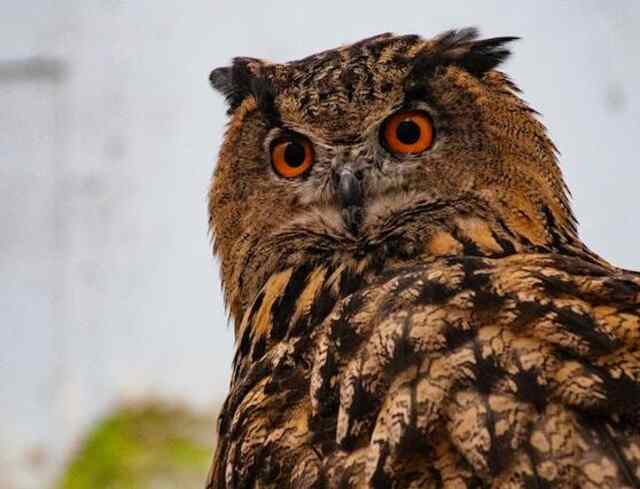
Comparing the Diets and Hunting Habits of Owls and Hawks
Birds of prey, such as owls and hawks, both hunt and consume prey. While not a common occurrence, owls are capable of eating hawks. Owls possess nocturnal habits and fly silently, which distinguishes them from hawks.
These skilled hunters have been known to attack and consume hawks that are similar in size. Owls are primarily carnivorous, consuming meat as their main source of nutrition. In contrast, hawks have a more diverse diet consisting of other birds, small mammals, reptiles, and insects.
Great horned owls are known to frequently feed on the young of other large birds, including crows, ravens, ospreys, and hawks. In some areas, great horned owls are the most significant predator of red-tailed hawk chicks.
Hawks, on the other hand, typically only prey on baby owls rather than adult owls, as both species can engage in a fair fight most of the time.
| Topic | Do Owls Eat Hawks? |
|---|---|
| Introduction | Owls are skilled hunters and have a diverse diet that includes small mammals, birds, and insects. |
| Owls’ Diet | Owls primarily prey on small rodents like mice or shrews. However, some owl species hunt other birds of prey, including hawks. |
| Great Horned Owls | Great horned owls are known to feed on the hatchlings of other large birds, including hawks. They are the most important predator of red-tailed hawk chicks in some areas. |
| Not a Regular Diet | Not all owls eat hawks, and it’s not a regular part of their diet. They typically hunt for food that is readily available and will consume whatever is most abundant in their habitat. They will also eat dead owl remains. |
| Interaction with Hawks | Hawks tend to avoid interacting with owls because of their unpredictability, but if a hawk is injured or weak, it may become prey for an owl. It’s also possible for an owl to take down a hawk if caught off guard or if the owl is hungry enough. |
| Conclusion | While it’s not common for owls to eat hawks, it is possible. Owls have a diverse diet and will consume whatever food is available in their habitat, but hawks tend to avoid interacting with owls. |

Other Differences Between Hawks and Owls
Appearance Differences Between Hawks vs Owls:
Hawks and owls have distinct differences in their physical appearance. Hawks are generally smaller than owls and have shorter wings and tails. They have sharp, curved beaks and powerful talons, which they use to catch their prey.
Owls, on the other hand, have larger heads, wider wingspans, and softer feathers that allow for silent flight. They have hooked beaks and sharp talons as well, but their eyes are forward-facing and larger than those of hawks.
Habitat Differences Between Hawks and Owls:
Hawks and owls also have different habitat preferences. Hawks are found in a variety of habitats, including open fields, forests, and wetlands. They prefer habitats with tall perches, such as trees or utility poles, that allow them to scan for prey.
Owls, on the other hand, are more commonly found in wooded areas, especially old-growth forests. They also inhabit deserts, tundras, and grasslands, but tend to avoid areas with heavy human activity.
Behavioral Differences Between Hawks and Owls:
In terms of behavior, hawks and owls have some distinct differences. Hawks are diurnal, meaning they are active during the day, while owls are nocturnal, meaning they are active at night.
Hawks are also more social than owls and can be seen hunting in pairs or groups. Owls are solitary hunters, and although some species are known to form monogamous pairs, they generally prefer to hunt alone.
Additionally, owls are known for their distinctive hooting calls, while hawks are generally quieter and communicate through screeches, hoots and other vocalizations.
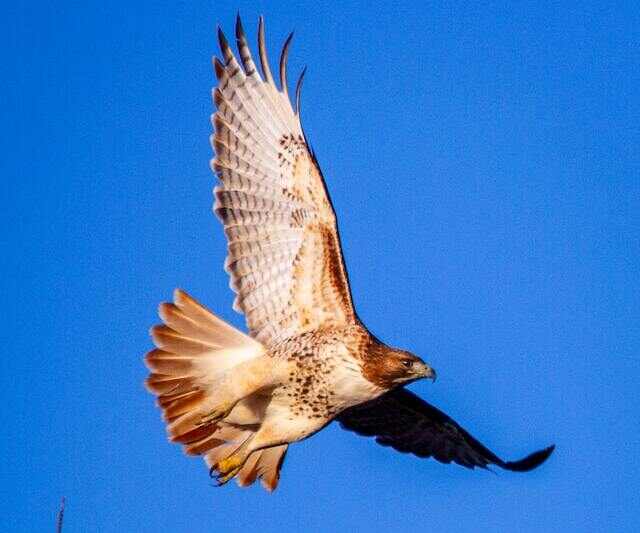
Do Hawks and Owls Really Fight?
Yes, hawks and owls can sometimes fight, especially when competing for territory or food. However, these interactions are relatively rare and usually occur between individuals of the same or similar species.
For example, two great horned owls may fight over a territory or a nesting site, or a red-tailed hawk may chase away a rival hawk from its hunting ground.
While hawks and owls are both birds of prey, they have different hunting styles and habitats, so direct competition between them is not as common as it may seem.
Do Owls Eat Hawks?
Owls are known to be great hunters with a varied diet that includes small mammals, birds, and insects. But can they eat hawks? Yes, it is possible, but it is not a frequent event.
Owls and Their Diet
Most owls usually prey on small rodents such as squirrels, mice or shrews. However, some species of owl hunt other birds of prey, such as hawks.
One example of the feeding habits of great horned owls is their consumption of the young offspring of other large birds, such as crows, ravens, ospreys, and hawks. In fact, they are the most important predator of red-tailed hawk chicks in some areas.
Not All Owls Eat Hawks
It’s important to note that not all owls eat hawks, and it’s not a regular part of their diet. Owls typically hunt for food that is readily available, and they will consume whatever is most abundant in their habitat. Although unable to hunt live owls, they are known to consume the carcasses of dead owls, which is commonly referred to as carrion.
Interaction Between Hawks and Owls
Hawks tend to avoid interacting with owls as they are unpredictable creatures that can hunt anyone in the darkness of the night. However, if a hawk is injured or weak, it may become prey for an owl.
It’s also possible for an owl to take down a hawk if it’s caught off guard or if the owl is hungry enough. Overall, while it’s not common for owls to eat hawks, it is possible.
Owls have a diverse diet and will consume whatever food is available in their habitat. However, hawks tend to avoid interacting with owls, and it’s not a regular part of an owl’s diet to hunt other birds of prey.
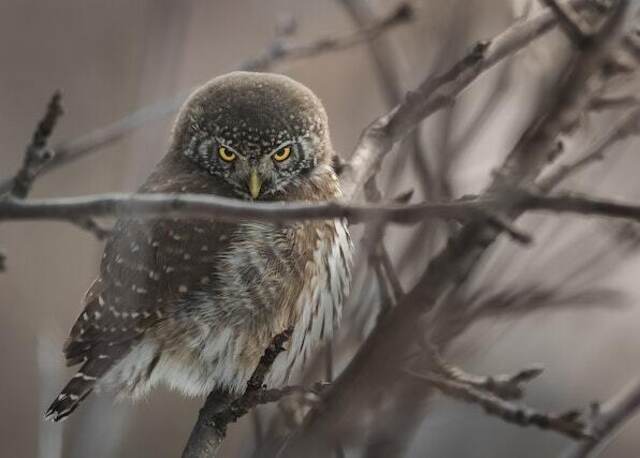
Owls’ Predatory Habits
Owls are fascinating birds that have intrigued humans for centuries. Their predatory habits and nocturnal lifestyle have made them a subject of curiosity and fascination. In this article, we’ll explore the world of owls and their predatory habits in more detail.
Nocturnal Hunters with Impressive Adaptations
Owls are primarily nocturnal hunters, which means they are most active at night. Their impressive adaptations allow them to hunt in complete darkness. Owls have large, round eyes that are fixed in their sockets, which gives them excellent binocular vision.
Their eyes are so large that they take up almost the entire space in their skulls. This allows them to see in very low light conditions and to spot prey from great distances. In addition to their eyes, owls have a keen sense of hearing that allows them to locate prey in complete darkness.
Their ears are asymmetrical, which allows them to pinpoint the exact location of their prey based on sound. The feathers around their ears help to funnel sound towards their ear openings, which enhances their hearing even further.
Silent Flight for Stealth Hunting
Another unique adaptation of owls is their silent flight. Their feathers have specialized edges that allow them to fly without making a sound.
Their ability to move silently enables them to approach their prey undetected. Owls also have soft down feathers that help to muffle any sound they might make while flying.
Opportunistic Predators with a Varied Diet
Owls are opportunistic predators, which means they will eat anything they can catch. They are known to hunt a wide variety of prey, including small mammals, insects, fish, and other birds.
Owls are skilled hunters and can take down prey that is much larger than themselves. Some species of owls, such as the Great Horned Owl, can even kill and eat skunks and porcupines, which are known for their defensive capabilities.
Territorial Birds with Aggressive Defense
Owls are also territorial birds that defend their hunting grounds from other predators. They will aggressively defend their nests and young from other birds, including hawks.
Owls are known to attack and kill other birds that venture too close to their territory. Some species of owls will even attack humans if they feel threatened.
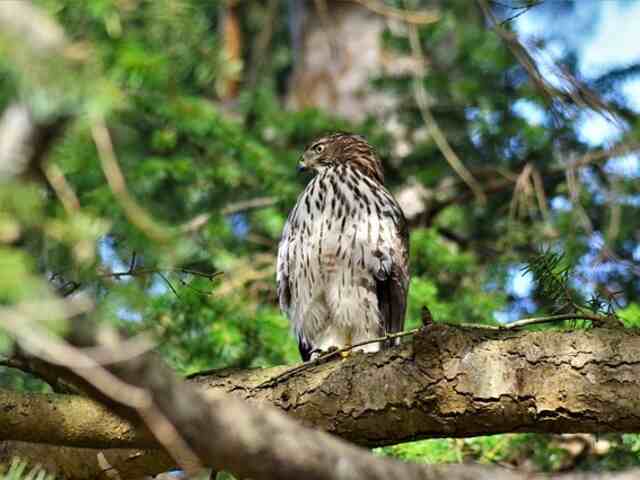
Owls’ Diet and Prey
Owls are carnivorous birds of prey that are known for their hunting skills and varied diet. In this section, we will take a closer look at the different types of prey that owls typically hunt and eat.
Small Mammals
Small mammals, including rodents such as mice, rats, voles, and shrews, make up a significant portion of an owl’s diet. Owls are also known to eat other small mammals like rabbits, squirrels, and even bats. With their excellent hearing, owls can locate their prey by sound alone, making them skilled nocturnal hunters.
Birds
Birds are another common prey for owls. Owls can hunt and eat a variety of birds, including small songbirds, larger birds like crows and hawks, and even other owl species. Despite their size, owls can take down prey that is much larger than themselves using their sharp talons and beaks.
Insects
Although not a significant portion of their diet, owls are not picky eaters and will also eat insects such as spiders, snails, crabs, and earthworms. Insects are an important source of food for owls, especially during times when other prey is scarce.
Reptiles and Amphibians
Owls are also skilled at hunting and eating reptiles and amphibians. They can catch and eat snakes, lizards, frogs, and toads. Owls are particularly valuable predators for catching reptiles and amphibians that are active at night.
Fish
Some species of owls, such as the fish owl, live near bodies of water and are known to hunt and eat fish. While fish may not make up a large portion of an owl’s diet, it is still an important source of food for some species.
Chickens and Other Domestic Birds
Owls can also be a problem for farmers and poultry owners, as they are known to hunt and eat chickens and other domestic birds. Owls are skilled hunters and can quickly decimate a flock if they are not kept away.
In conclusion, owls are skilled hunters with a varied diet that includes small mammals, birds, insects, reptiles and amphibians, fish, and even chickens and other domestic birds. They play an important role in many ecosystems as predators, helping to keep populations of other animals in check.
| Types of Prey | Examples |
|---|---|
| Small Mammals | Mice, rats, voles, shrews, rabbits, squirrels, bats |
| Birds | Songbirds, crows, hawks, other owl species |
| Insects | Spiders, snails, crabs, earthworms |
| Reptiles and Amphibians | Snakes, lizards, frogs, toads |
| Fish | Fish owl species |
| Domestic Birds | Chickens, other domestic birds |
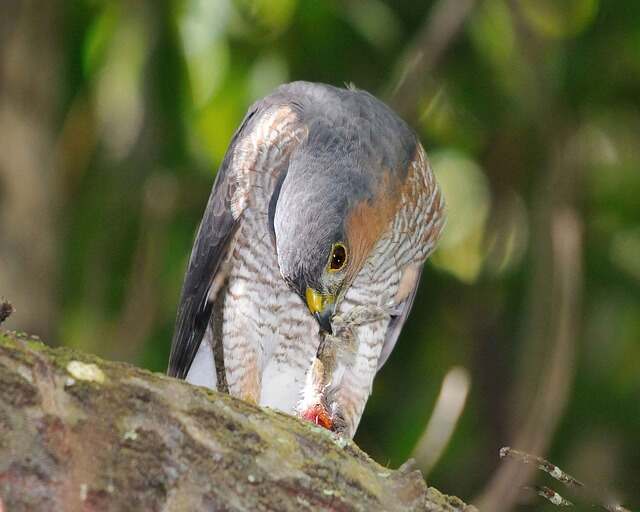
Types of Owls that Prey on Hawks: A Guide
When it comes to hunting, some owls are more aggressive and powerful than hawks, making them formidable predators in their own right. In this guide, we will explore the different types of owls that are known to eat hawks.
Great Horned Owls
Great Horned Owls are one of the most aggressive owl species. These birds are capable of taking down prey much larger than themselves, including hawks. They are adaptable and widespread, found throughout North and South America.
Barn Owls
Barn Owls are known for their heart-shaped faces and their ability to hunt in complete darkness. These owls are found in North America, Europe, and Asia and are known to prey on hawks.
Barred Owls
Barred Owls are opportunistic hunters that eat a wide variety of prey, including hawks. They are known for their distinctive “who cooks for you” call and their aggressive behavior. These birds are found throughout much of North America.
Snowy Owls
Snowy Owls are large, white birds that live in the Arctic tundra. They are known for their unique appearance and their ability to hunt in harsh environments. Snowy Owls are also known to eat hawks.
Short-Eared Owls
Short-Eared Owls are found throughout the world and are recognizable by their yellow eyes and ear tufts. These birds are opportunistic hunters that eat a variety of prey, including hawks. They are typically found in open habitats such as grasslands and marshes.
Screech Owls
Screech Owls are found throughout much of North America and are known for their trilling call. These owls are opportunistic hunters that eat a wide variety of prey, including hawks. They are typically found in woodland habitats and blend in with their surroundings.
Overall, these are the different types of owls that prey on hawks. Learning about these amazing creatures is fascinating for birdwatchers and nature enthusiasts alike.
| Type of Owl | Hawks Preyed on |
|---|---|
| Great Horned Owl | Various types of hawks, including Red-tailed Hawks and Cooper’s Hawks |
| Barn Owl | Various types of hawks, including Red-tailed Hawks and Sharp-shinned Hawks |
| Barred Owl | Various types of hawks, including Red-shouldered Hawks and Cooper’s Hawks |
| Snowy Owl | Various types of hawks, including Rough-legged Hawks and Northern Harriers |
| Short-Eared Owl | Various types of hawks, including Northern Harriers and American Kestrels |
| Screech Owl | Various types of hawks, including Cooper’s Hawks and Sharp-shinned Hawks |
This table lists the types of owls that are known to prey on hawks, along with the specific types of hawks they prey on. Each of these owl species is capable of taking down hawks, and they are all known for their impressive hunting abilities.
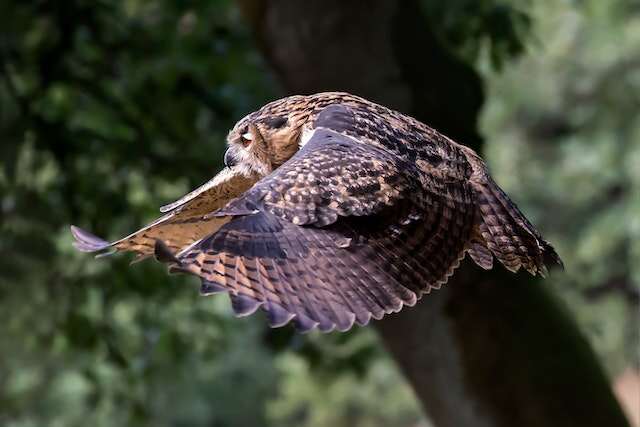
Hawks: Predators and Prey
Hawks are known for their hunting abilities, capturing a variety of prey including birds, rodents, and reptiles. However, even skilled predators like hawks can become prey themselves. In fact, larger birds of prey such as eagles and owls have been known to attack and kill hawks.
Red-Tailed Hawks: Vulnerable Predators
One species of hawk that can fall prey to other birds of prey is the Red-tailed Hawk. These hawks are widespread throughout North America and are identifiable by their reddish-brown tails.
Despite their hunting skills, they can become prey themselves, especially to larger birds of prey like eagles and Great Horned Owls.
When nesting, Red-tailed Hawks are also vulnerable to other predators such as raccoons and snakes. These predators can climb trees and raid hawk nests, stealing eggs and killing young chicks.
Adaptable and Dominant
Despite their vulnerability, Red-tailed Hawks remain a dominant predator in many ecosystems. They are adaptable and can thrive in various habitats such as forests, deserts, and urban areas.
Their impressive hunting skills include soaring high in the sky to spot prey and using sharp talons to capture and kill their targets.
In conclusion, while hawks are skilled predators, they can still become prey themselves. Red-tailed Hawks, in particular, can fall victim to larger birds of prey and other predators when nesting.
Nevertheless, they remain important predators in many ecosystems, admired for their hunting abilities and adaptability.
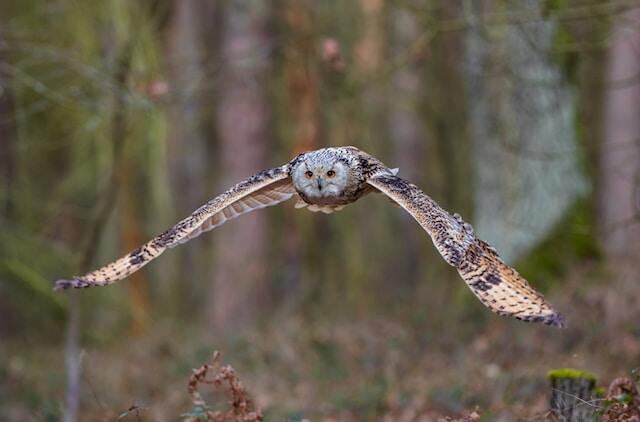
FAQs: Do Owls Eat Hawks?
When it comes to the predator-prey relationship in the animal kingdom, owls and hawks are two birds of prey that coexist in the same habitats. This raises the question: do owls eat hawks? Here are some frequently asked questions about owls eating hawks.
Do All Owl Species Eat Hawks?
While all owl species are carnivorous and hunt for prey, not all of them eat hawks. According to Birds Authority, most owls will eat other birds, including hawks, but it’s not their primary food source. Great horned owls have been known to feed on hawks, but they don’t actively hunt them.
Why Would an Owl Eat a Hawk?
Owls are opportunistic hunters and will eat whatever prey is available to them. If a hawk is within an owl’s territory, and the opportunity arises, the owl may attack and eat the hawk.
Do Hawks Attack Owls?
Yes, hawks and owls are both territorial and may attack each other when either one of them crosses boundaries. However, hawks are more likely to attack owls, especially baby owls, because they are perceived as competition.
What Other Animals Do Owls Eat?
Owls are skilled hunters and can take down prey that is much larger than themselves. Their diet includes small mammals such as rabbits, rodents, and squirrels, as well as birds, reptiles, amphibians, and insects. Some owl species, such as the barred owl and barn owl, may also eat fish.
How Do Owls Hunt?
Owls are nocturnal hunters and have excellent hearing and vision, which allows them to locate prey in the dark. They use their sharp talons and hooked bills to catch and kill their prey. Some owl species, such as the snowy owl and short-eared owl, may also use their wings to flush out prey from hiding places.
Are Owls Scared of Hawks?
Owls are not necessarily scared of hawks, but they are territorial and will defend their territory against any perceived threats. If a hawk is within an owl’s territory, the owl may attack the hawk to protect its territory. However, if the hawk is not perceived as a threat, the owl may ignore it.
What do owls do to hawks?
Owls are known to prey on hawks, but they also compete with them for resources such as nesting sites and hunting grounds. In some cases, they may attack hawks if they feel threatened or if the hawk is intruding on their territory.
Is a hawk stronger than an owl?
In terms of physical strength, hawks are generally considered stronger than owls. They have more powerful talons and a stronger grip, which allows them to take down larger prey. However, owls are skilled hunters and can compensate for their slightly weaker grip with their other hunting abilities.
What eats a hawk?
Hawks are predators and are typically not preyed upon by other animals. However, larger birds of prey such as eagles and owls have been known to attack and kill hawks. Additionally, some mammals such as coyotes and foxes may occasionally prey on young or injured hawks.
What is the food chain of an owl?
As predators, owls occupy a high position in the food chain. They feed on a variety of prey including small mammals such as mice and voles, birds, reptiles, and insects. Owls are themselves preyed upon by larger predators such as eagles and coyotes.
Can an owl take down a hawk?
Yes, some species of owls are known to prey on hawks. Great Horned Owls, for example, are capable of taking down prey much larger than themselves, including hawks. However, hawks are also skilled hunters and are capable of defending themselves against owls.
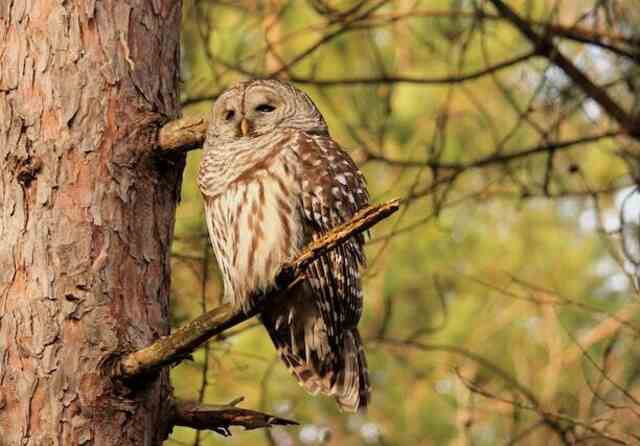
Conclusion
In conclusion, while not all owl species eat hawks, it is possible for them to do so if the opportunity arises. Owls are opportunistic hunters and will eat whatever prey is available to them.
Hawks and owls are both territorial and may attack each other when either one of them crosses boundaries. However, hawks are more likely to attack owls because they are perceived as competition.
Owls are skilled hunters and can take down prey that is much larger than themselves, and their diet includes small mammals, birds, reptiles, amphibians, insects, and sometimes fish.
Therefore, while owls eating hawks may not be a common occurrence, it is a fascinating aspect of the predator-prey relationship in the animal kingdom.

